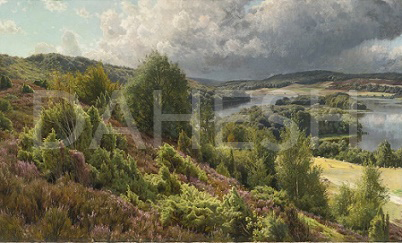Born at the end of the “ Golden Age” of Danish painting (from around 1800 to 1860), Peder Mønsted established his reputation primarily as a naturalist landscape artist—especially admired for his poetic point of view. His first artistic training was at the Prince Ferdinand School of Art in Aarhus, Denmark where he studied with the landscape painter Andreas Fritz, who influenced the young artist’s development. Mønsted then entered the Copenhagen Academy in 1875, but he left in 1879 without taking his final examination, choosing instead to continue his studies independently with established artists, including the Danish Realist genre and landscape painter Peder Severin Krøyer and French Academic painter William-Adolphe Bouguereau.
Mønsted was best known for his ability to capture ‘types’ of landscapes, scenes of nature that embodied the essence of a country or region. He traveled throughout Europe, the Mediterranean, North Africa, and Middle East, painting such views, visiting Italy, France, Switzerland, Norway, Greece, Algiers, and Egypt. His most popular paintings, however, were scenes from Scandinavia, especially his native Denmark. The Dahesh holds two of Mønsted’s Nordic landscapes, one from Denmark and another from Norway. Together they illustrate the different ways in which the painter found endless variety on nature’s effects and the changing seasons.
Heather-covered Hills by the Lakes near Silkeborg (1907) is a poetic vision of the verdant banks of the River Guden — Denmark’s longest waterway. The work reflects the various schools that dominated Danish landscape painting throughout the 19th century—the attention to native topography is a hallmark of Danish “Golden Age” painting, while the encroaching storm and dramatic scene speak to the growing interest in symbolic and subjective views of nature. The work is a study in detail of the lush foliage in the foreground, while his love of his native topography is emphasized by the monumental proportions of the work. In contrast to this diversity of natural forms, Mønsted’s Snow Scene (ca. 1917–18) combines the artist’s penchant for detailed brushwork, and an Impressionist sensitivity to light that is reminiscent of Claude Monet’s The Cart. Snow-covered Road at Honfleur (ca. 1867, Musée d’Orsay). As can be seen in both, the emphasis is on the way that light plays across the surface of snow, as well as the infinite shades of white found in the same substance.




